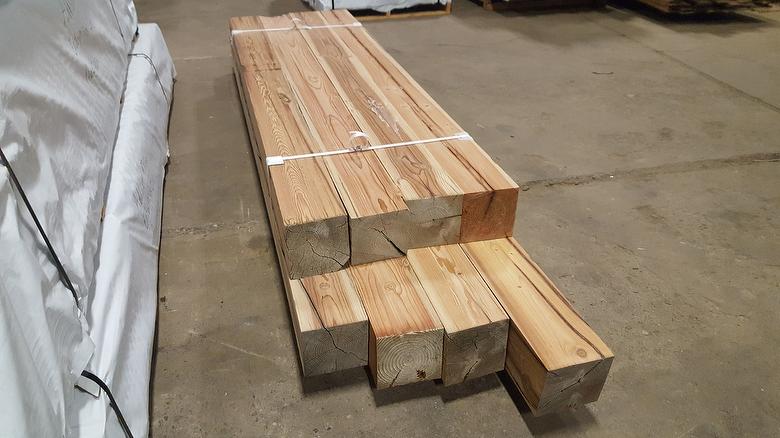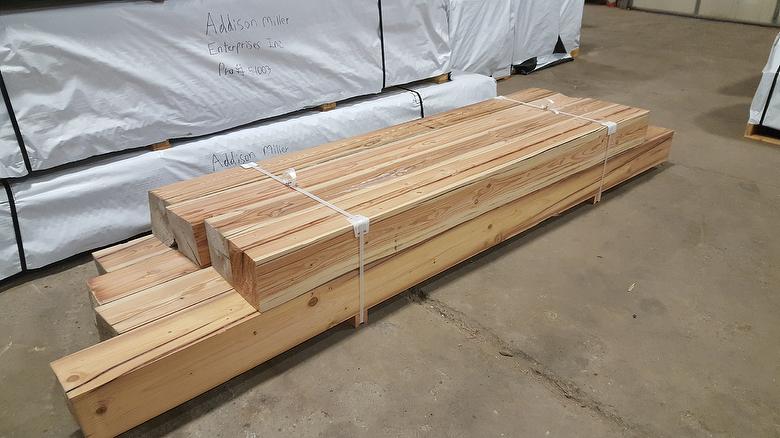Trestlewood II "Salty Fir" S4S Timbers
Trestlewood II "Salty Fir" S4S Timbers
Specification Sheet #1101 - Trestlewood II (Salty Fir) Timbers
Request Quote
Height
Width
Length
Quantity
3-14"
3-16"
to 32'
min: 1 each
Related Productline Pages
Trestlewood II Salty Fir S4S
Specification Sheet #1101 - Trestlewood II (Salty Fir) Timbers
Species
Douglas Fir
Source
Piling of Lucin Cutoff Railroad Trestle--Great Salt Lake
HC/FOHC
Heart Center (HC)
Metal/Holes
Some Trestlewood II timbers (especially larger and longer ones) contain a few 1" diameter holes where metal has been removed. Such holes are generally surrounded by streaking black stains.
Moisture Content/Stability
Water saturated (often with significant air drying)
Surfacing
Circle-Sawn, Band-Sawn, Planed or Circle-Sawn Weathered
Standard Dimensions
a) Cross-sections: 8x8 to 10x10; b) Lengths: to 16'; c) Target Dimensions: circle-sawn timbers are targeted at full-sawn dimensions; band-sawn and planed timbers are targeted at 1/2" under full-sawn for dimensions listed as less than 6" and 3/4" under full-sawn for dimensions listed as 6" and above; d) Tolerances: circle-sawn timbers are cut to the stated dimensions +/- 1/4"; band-sawn timbers are cut to the stated dimensions +/- 1/8"; planed timbers are planed to the stated dimensions +/- 1/16" (planed timbers greater than 8" thick and/or 14" wide will be hand-planed and will have somewhat greater tolerances than machine-planed timbers.)
Available Dimensions
a) Cross-sections: to 14x16; b) Lengths: to 32' (longer lengths may be possible on a case-by-case basis);
c) Target Dimensions: circle-sawn timbers are targeted at full-sawn dimensions for dimensions to 12" and 1/2" nominal dimensions for dimensions over 12"; band-sawn and planed timbers are targeted at 3/4" under full-sawn; d) Tolerances: circle-sawn timbers are cut to the stated dimensions +/- 1/4"; band-sawn timbers are cut to the stated dimensions +/- 1/8"; and planed timbers are planed to the stated dimensions +/- 1/16" (timbers greater than 8" thick and/or 14" wide will be hand-planed and will have somewhat greater tolerances than machine-planed timbers.) Tolerances can be somewhat greater for timbers wider than 12" and/or longer than 20'.
c) Target Dimensions: circle-sawn timbers are targeted at full-sawn dimensions for dimensions to 12" and 1/2" nominal dimensions for dimensions over 12"; band-sawn and planed timbers are targeted at 3/4" under full-sawn; d) Tolerances: circle-sawn timbers are cut to the stated dimensions +/- 1/4"; band-sawn timbers are cut to the stated dimensions +/- 1/8"; and planed timbers are planed to the stated dimensions +/- 1/16" (timbers greater than 8" thick and/or 14" wide will be hand-planed and will have somewhat greater tolerances than machine-planed timbers.) Tolerances can be somewhat greater for timbers wider than 12" and/or longer than 20'.
Weight
Typically, approximately 4 pounds per board foot
Grading
Trestlewood II timbers can be graded (WLCB or WWPA) upon request. Timbers are graded with exception taken for any holes, notches, etc. It is highly recommended that any Trestlewood II timbers that are to be used in a structural application be graded. It is also recommended that standard size Trestlewood II timbers be used whenever possible. Checking, holes (where metal has been removed) and wane tend to be more pronounced in Trestlewood II timbers wider and/or thicker than 10" than in standard size Trestlewood II timbers. A high moisture content should be assumed when consulting design value tables. See also: "Strength" section of Trestlewood II Features/Issues summary.
Stability
Trestlewood II timbers have proven to be stable. Like all wood, undried Trestlewood II will experience some shrinkage and develop seasoning checks as it dries. The drying process also often widens any "prior use checking" associated with Trestlewood II's life of service as railroad trestle piling. Trestlewood II does not, in general, twist or warp as much as green timbers.
Salt/Minerals
Trestlewood contains significant amounts of salt and other minerals (often 20%+ by weight), creating special characteristics and/or considerations like those described in the following items.
Color/Appearance
The coloring of individual Trestlewood II timbers varies widely, from normal Douglas Fir coloring to color combinations unique to Trestlewood II. Surfacing and finishes impact final timber coloring. Color variations are more noticeable in planed timbers than in circle-sawn or band-sawn timbers.
Finishes/Glues
Certain finishes and glues do not work well with Trestlewood II. Most importantly, DO NOT USE WATER-BASED FINISHES. We tend to favor penetrating oil finishes on Trestlewood II timbers and other non-kiln-dried Trestlewood II products because they allow the wood to breathe, thereby facilitating efficient air drying.
Fire Retardance
Schuller International performed an ASTM E-84 Flame Spread test on a Trestlewood II piling sample in January, 1995. The resulting index value was 16, well below the maximum index value of 25 for a Class I fire retardant. Normal Douglas Fir has a flame spread index of 70 to 100. Only a few wood species have flame spread index values less than 75. Fire retardant treatments are generally necessary to meet Class I (and often to meet Class II.)
Metal Corrosiveness
Trestlewood II can have a corrosive effect on metal fasteners, machinery and saw blades. High grade stainless steel fasteners should be used in lieu of regular steel fasteners, especially in applications involving the likely mixing of Trestlewood II, moisture and oxygen.
Moisture
Trestlewood II absorbs moisture more readily than typical Douglas Fir. Trestlewood II timbers (especially timbers with air dry time) should be handled, stored and transported carefully to minimize any unnecessary reabsorption of moisture. Trestlewood II products should only be used in humid environments after you have carefully considered Trestlewood II characteristics and the implications of those characteristics for your application.
Odor
Wet Trestlewood II timbers often have a Great Salt Lake and/or musty smell to them. This odor is especially strong as wet timbers are being cut or otherwise processed. It tends to become less and less of an issue as timbers are allowed to air dry and are kept dry. Our experience suggests that a Trestlewood II odor is most likely to be noticeable in situations involving moisture or high humidity; limited ventilation / air circulation; and/or uncoated/unsealed Trestlewood II products. We believe the most important step in minimizing Trestlewood II odor issues is to control moisture by facilitating the efficient air drying of non-kiln-dried Trestlewood II products and minimizing any reintroduction of moisture.
Salt Leaching
As moisture is drawn out of Trestlewood II timbers, it brings salt with it. Salt leaching tends to be the most concentrated at knots and timber ends, but can happen anywhere. Air dry time reduces, but does not eliminate, salt leaching. Approaches to salt leaching include sanding and refinishing impacted areas to doing nothing (and letting the salt serve as one of the most visible evidences of the history and reclaimed nature of Trestlewood II timbers.) Salt is more visible on planed timbers than on circle-sawn or band-sawn timbers.
Additional Information
See the current Trestlewood II Features/Issues summary for additional information about Trestlewood II characteristics and their practical implications. This summary is for informational purposes only and is not a part of the Trestlewood II timbers specification sheet.










